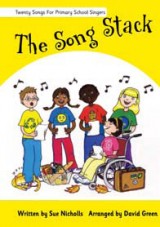Sing your way through the curriculum using these ideas from author, composer and music education consultant, Sue Nicholls...
Singing is good for you! It releases endorphins, harnesses that ‘feel good’ factor and engages and focuses young minds. Singing is definitely a tool for learning too. Lyrics can embed ideas and facts more easily than mere spoken words and a song can act as a conduit to link many other subject areas, providing a real epicentre for a topic or theme. Doo-bi-doo from The Song Stack, published by Music Education Supplies, works well as an example of a song used to springboard crosscurricular activities: to instigate, stimulate and shape ideas that develop teaching and learning in a connected way.
| Call: Doo-bi-doo! |
Response: Doo-bi-doo! Doo-bi-doo! |
| Call: Who’s leading this rap? | Response: It’s you, it’s you! |
| Call: Do we keep the beat? | Response: We do, we do! |
| Call: What’s in the pot? | Response: It’s stew, it’s stew! (pitch moves up a note) |
| Call: Here’s a plate of chips | Response: Let’s chew, let’s chew! |
| Call: And the man in the plane? | Response: He flew, he flew! |
| Call: What’s the colour of the sky? | Response: It’s blue, it’s blue! |
| Call: What did Cinderella drop? | Response: Her shoe, her shoe! (pitch moves up a note) |
| Call: And Jack’s magic beans? | Response: They grew, they grew! |
| Call: Who stole the treasure? | Response: The crew, the crew! |
| Call: Pigeons on the roof? | Response: They coo, they coo! |
| Call: how about the owl? | Response: Twit twoo, twit twoo! (pitch moves up a note) |
| Call: And the cows in the field? | Response: They moo, they moo! |
| Call: Here’s the Tardis man | Response: Doctor Who, Doctor Who! |
| Call: Aren’t we just the best? | Response: It’s true, it’s true! |
| Call: Doo-bi-doo, Doo-bi-doo! | Response: Doo-bi-doo, Doo-bi-doo! |
Call and response: Doo-bi-doo, Doo-bi-doo!
Doo-bi-doo is a sung rap that uses just four notes and two ‘call and response’ (or ‘question and answer’) phrases. It has a very precise structure in which each of the leader’s short ascending phrases is answered by the group who sing a descending tune: in other words the answering phrase is a reversal or reflection of the leader’s part. The pitch moves up a note on every fourth line, which sustains the singers’ interest, demands focused listening and challenges singers to keep the tuning accurate. Try using a set of flip cards bearing the singers’ responses or simply put them on the whiteboard. The song suits Y3 and Y4 but can be used by older children as a singing warm-up, especially with pupils adopting the leader’s role!
The style is relaxed, so encourage your singers to add some stepping from side to side and finger clicks to give a more upbeat performance. Once the song is familiar, invite soloists from the group to take the lead and if appropriate, encourage pupils to find ways of developing harmony parts in the responses.
Using the ideas, themes and structures found in Doo-bi-doo, you can develop other curricular areas at KS2, for example:
Hello Around the Ring is a simple ‘question and answer’ dialogue chant to pass around the circle to a strong rhythmic beat, using a drum or tambour. The chant lets everyone ask the questions and give the answers. Person A starts by addressing the person on his or her left and the idea is to keep the game going all around the circle, without a break.
A: You OK?
B: Just about!
A: How’s your neighbour?
B: I’ll find out! [Person B is now person A]
*A: You OK?
B: Just about!
A: How’s your neighbour?
B: I’ll find out!
*Person B turns to the person on his/her left and
becomes Person A.
Hello Around the Ring taken from Singing Breakfast Clubs and reproduced here by kind permission of ContinYou http://www.continyou.org
Change the rhyming vowel in Doo-bi-doo from ‘oo’ to ‘ee’ and challenge pupils to write their own version to the original model. The following outline scaffolds the activity, by giving ‘answers’ for a few lines and then asking the songwriters to invent both the ‘call’ and ‘response’:
| Call: | Tweedle dee! Tweedle dee! | Response: | Tweedle dee! Tweedle dee! |
| Call: | ................. | Response: | It wasn’t me! |
| Call: | ................. | Response: | It’s a tiny flea! |
| Call: | ................. | Response: | In the rolling sea! |
| Call: | ................. | Response: | On a big oak tree! |
| Call: | ................. | Response: | It’s free, its free! |
| Call: | ................. | Response: | I’m going to ski! |
| Call: | ................. | Response: | ................. |
| Call: | ................. | Response: | ................. |
| Call: | ................. | Response: | ................. |
Dance
Adapt the call and response structure in this simple dance warm-up. The pupils work in pairs and maintain eye-contact throughout. The first dancer uses four steps to travel a short distance, ending with a pose or statue, which is ‘held’ while their partner travels their own four steps and responds with a different pose. This pattern continues until each dancer has performed four times. Just as the sung ‘call’ and ‘response’ are of equal length but differ musically, so each dancer’s sequence has a similar structure but a different outcomes.
Art
Develop the ‘reflection’ aspect of the song by exploring the work of Claude Monet to inspire paintings, torn paper collage or art work in other media. Why not design a sequence of cartoons and caricatures to act as mnemonics for words and characters mentioned in the lyrics?
ICT
Use software (e.g. 2Simple) to create pictures which can then be reversed or reflected. Take portrait photographs and create an altered face by reversing and replacing half of the original face, so that you end up with a ‘new’ face that is really a left-hand side juxtaposed with a reversed left-hand side! The results are quite fascinating!
Science
Use mirrors to investigate and explore reflection and experiment with images from concave and convex surfaces.
 Create paired call and response pieces by removing the A bars from a xylophone or glockenspiel so each player has five notes: C to G. Improvise question and answer phrases of equal length but which have contrasting melodies (tunes). Pupils could use the rhythm pattern of Doo-bi-doo to scaffold first attempts. These improvisations can be refined, polished and developed to become compositions for a performance.
Create paired call and response pieces by removing the A bars from a xylophone or glockenspiel so each player has five notes: C to G. Improvise question and answer phrases of equal length but which have contrasting melodies (tunes). Pupils could use the rhythm pattern of Doo-bi-doo to scaffold first attempts. These improvisations can be refined, polished and developed to become compositions for a performance.
These KS2 activities don’t attempt to cover every curricular area, but aim to demonstrate that a song can provide strong connections to other subject areas and provide valid and interesting links within and across the curriculum.
Sue Nicholls has written many books for generalists, demonstrating an accessible and practical approach to delivering the music curriculum; she has also contributed material to other song collections. Sue is a ‘Sing Up’ Vocal Force facilitator and works as an independent education consultant delivering training nationwide. For more details visit http://www.suenichollsmusic.com or email .(JavaScript must be enabled to view this email address)
 Thanks to Sing Up, the excellent national singing programme, schools now have access to a massive Song Bank resource to support children’s singing. If you haven’t yet registered, do so at http://www.singup.org and avail yourself of vast range of free material and training to nurture and sustain singing in your setting.
Thanks to Sing Up, the excellent national singing programme, schools now have access to a massive Song Bank resource to support children’s singing. If you haven’t yet registered, do so at http://www.singup.org and avail yourself of vast range of free material and training to nurture and sustain singing in your setting.
A recording of Doo-bi-doo and a copy of the musical notation has been made available to readers of Teach Primary! by kind permission of Music Education Supplies; go to ‘free resources section’ http://www.mesdirect.com to hear or download the song.
Boosting children’s self esteem
Ace-Classroom-Support
Use scaffolding to wean children off high levels of TA support
Ace-Kitchen-Manager
